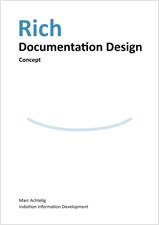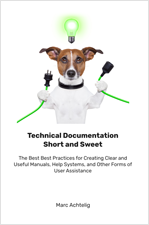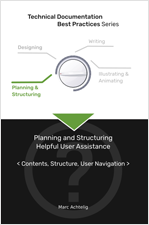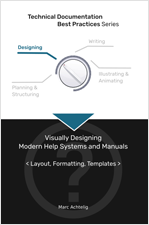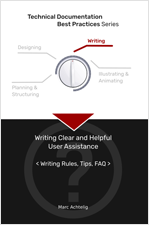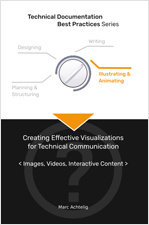My books and ebooks on technical documentation
My practical books on technical documentation support you in creating clear, user-friendly user manuals and online help — with clear rules and recommendations.
NEW: Rich Documentation Design Concept
Technical documentation is all the more valuable the faster it delivers exactly the information its users need at any given moment. Like an energy bar for an athlete, rich documentation provides many readily available calories with little volume. The Rich Documentation Design Concept supports creating documentation that has a high “nutrient density”: rich in immediately usable content, poor in useless dead weight.
|
Note: The preview includes the entire document. If you find the content useful, please purchase a copy. Thank you. |
Achtelig, Marc
Rich Documentation Design Concept
Methods for Creating Concise Technical Documentation of Maximum Value
English Edition
58 pages in A4 format
Most people can handle technology much better today than in the past. In addition, many products are becoming increasingly easy to use. However, many classic documentation concepts are still based on the dogmas of “consistency” and “completeness”.
Due to the wealth of functions and settings that many products offer today, such documentation is hardly any longer manageable – neither for its authors nor for its users. Despite the high effort put into writing such documentation, users often learn a lot of useless and trivial things. In extreme cases, for example, they learn that they can save their data using the “Save” function, or that the “Print” function is used to print a document. The few important and relevant pieces of information about backgrounds and correlations are buried in the documentation and are not found.
Creation, maintenance, translation, and printing of the documentation are more expensive than necessary. Yet the result is not optimal. Users must laboriously separate valuable content from irrelevant clutter. This costs time and energy. User experience? Poor.
This does not mean that established documentation concepts and methods are inappropriate. But it is time to reinterpret and to rethink them at one point or another. It is also time to take more account of the fact that a lot of documentation today is online documentation, which presents a whole new set of possibilities compared to documentation printed on paper or compared to a PDF file.
For more than 25 years of consulting and editorial work, I have encountered this issue in almost every project. With growing urgency. To standardize solutions and to allow others to also benefit from them, the Rich Documentation Design Concept with its Impulse Method and its Minimal Brainwork Principles emerged.
Technical Documentation Short and Sweet
Do you need to write some technical documentation? Do you want to do a good job but don’t have much time that you can spend? The book provides hands-on advice and simple, catchy examples—free from theoretical elaborations, highbrow grammar terms, and other shoptalk.
|
Note: The original book has significantly more pages than this preview. If you like the book and actually read larger sections, please be fair and buy a copy. Thank you. |
Achtelig, Marc
Technical Documentation Short and Sweet
The Best Best Practices for Creating Clear and Useful Manuals, Help Systems, and Other Forms of User Assistance
Approx. 330 pages; ISBN of the printed edition: 978-3-943860-15-3
Also available as an ebook for immediate download:
Do you want to make the user manuals or online help systems of your products stand out from those of your competitors but don’t have the time to study a dozen all-embracing textbooks about technical writing before getting down to work?
This book provides you with a compilation of those best practices that are going to make a real difference. You get hands-on advice and simple, catchy examples—free from theoretical elaborations, highbrow grammar terms, and other shoptalk.
The book is exemplary for what you need to achieve as well: deliver the essential information on as few pages as possible in a clear and simple form.
Topics covered:
▪Structuring principles, including building topics, establishing headings, and determining the best possible order of information
▪Layout and formatting essentials
▪General technical writing rules
–Rules for building sections
–Rules for building sentences
–Plain language
–Grammar and word choice FAQ
▪Creating images of hardware and software
▪Video design
Technical Documentation Best Practices Series
The Technical Documentation Best Practices Series is a compilation of hands-on books that encompass the whole process of creating user manuals, online help systems, screencasts, plus other forms of user assistance and technical communication.
Each book of the series covers one specific task in the process so that people who are involved in only one phase of a technical documentation project can easily focus on just that part.
The books in the series strictly avoid all sorts of lengthy theory but provide best practices, hands-on solutions, clear recommendations, working aids, and examples that you can easily remember and readily apply to your own work.
Planning and Structuring User Assistance
|
Note: The original book has significantly more pages than this preview. If you like the book and actually read larger sections, please be fair and buy a copy. Thank you. |
Achtelig, Marc
Technical Documentation Best Practices:
Planning and Structuring Helpful User Assistance – Contents, Structure, User Navigation
Approx. 170 pages; ISBN of the printed edition: 978-3-943860-12-2
Also available as an ebook for immediate download:
Even the best information is worthless if users can’t find it. Providing user-friendly structure and navigation is just as important as providing well-written content. However, structuring user assistance isn’t as simple and obvious as it may seem. If you think that your document structure should follow the structure of your product’s components and functions: You’re wrong. If you think that the type of document that you prefer is the same type of document that your clients prefer: You’re wrong. If you think that all the information that you have is important: You’re also wrong.
This book tells you how to structure, index, and link your documents so that readers actually find the information they need.
Topics covered:
▪General structuring principles that all structural decisions have in common.
▪Choosing media: Should you provide a printed or printable user manual (PDF), online help, or both? What information should go into the user manual, and what information should go into online help? Which help format should you use? Can context-sensitive help calls be implemented? Should you provide interactive features?
▪Planning documents: Should you put all information into one document, or should you supply several user manuals for specific purposes and user groups? How should you name your documents?
▪Planning document sections: What are the major sections that your documents should consist of? Are there any standard sections that you mustn’t forget?
▪Planning topics: What types of information do your clients need? How should you build and name the individual topics within the document?
▪Planning the order of sections and topics: How should you organize the sections and topics within your documents? What comes first? What comes later?
▪Planning navigation: Which navigational devices should you provide in printed documents and in online help systems? Where should you provide links or cross-references and where not?
Designing Templates and Formatting Documents
|
Note: The original book has significantly more pages than this preview. If you like the book and actually read larger sections, please be fair and buy a copy. Thank you. |
Achtelig, Marc
Technical Documentation Best Practices:
Visually Designing Modern Help Systems and Manuals – Layout, Formatting, Templates
Approx. 230 pages; ISBN of the printed edition: 978-3-943860-13-9
Also available as an ebook for immediate download:
Aesthetics isn’t the only thing that you should be striving for when desiging a user manual template or the style sheet of an online help system. When creating technical documentation, usability, readability, and simplicity are at least just as crucial.
The design should please the eye, but at the same time it must communicate the content clearly. In addition, paragraph styles and character styles should be efficient to use for the author when writing the document. The layout process should be automated as much as possible. Because most user assistance documents are frequently updated during theit life cycle, an automated layout process is much more important here than with other kinds of literature.
Setting up templates and style sheets that are efficient to use when creating and updating user assistance requires a lot of experience in technical writing. The rules presented in this book are the essence of this experience.
All chapters provide various examples that you can use for inspiration and as starting points for your own designs.
Topics covered:
▪Layout basics
▪Setting the type area
▪Choosing fonts and spacing
▪Creating semantic styles
▪Organizing styles hierarchically
▪Recommended screen layouts
▪Recommended page layouts
▪Recommended table designs
▪Recommended paragraph styles
▪Recommended character styles
Writing Plain Instructions
|
Note: The original book has significantly more pages than this preview. If you like the book and actually read larger sections, please be fair and buy a copy. Thank you. |
Achtelig, Marc
Technical Documentation Best Practices:
Writing Clear and Helpful User Assistance – Writing Rules, Tips, FAQ
Approx. 350 pages; ISBN of the printed edition: 978-3-943860-14-6
Also available as an ebook for immediate download:
Users want manuals that are easy to read, with short sentences, simple words, and unambiguous instructions. Unfortunately, writing plain language is much more difficult than writing overblown instructions that only an expert can understand. Writing complex texts is simple—writing simple texts is complex.
This book shows you how to write simple user assistance rather than complex user annoyance. As it’s a book about stating your message clearly, it also states its own messages clearly. It’s free of boring theory and free of highbrow grammar terms, but gives you clear recommendations and catchy examples that you can easily remember and apply to your own work.
Topics covered:
▪General technical writing principles that make your texts plain, simple, and easy to understand.
▪On the topic level: Rules for writing “Concept topics,” “Task topics,” and “Reference topics.”
▪On the paragraph level: Rules for writing the standard elements that form a topic, such as headings, subheadings, procedures, lists, tables, warnings, notes, tips, examples, cross-references, and links.
▪On the sentence level: Rules for building plain and unambiguous sentences.
▪On the word level: Recommendations for using simple words.
▪Spelling and punctuation FAQ.
▪Grammar and word choice FAQ.
▪Standard terms and phrases.
Illustrating and Animating Help and Manuals
|
Note: The original book has significantly more pages than this preview. If you like the book and actually read larger sections, please be fair and buy a copy. Thank you. |
Achtelig, Marc
Technical Documentation Best Practices:
Creating Effective Visualizations for Technical Communication – Images, Videos, Interactive Content
Approx. 340 pages; ISBN of the printed edition: 978-3-943860-10-8
Also available as an ebook for immediate download:
Words are not always the best medium for communicating technical information. Sometimes, a picture, a simple animation, or a short video can intuitively show within a few seconds what words can hardly describe.
However, there are also cases in which pictures are too complicated and videos are too slow in conveying information. For effective technical communication, images and videos need to be used exactly where they are most efficient, and they need to be designed to clearly convey their particular message.
This book shows you the principles of creating effective visuals.
Topics covered:
▪Choosing the right medium and place: What works best in a particular case: Text? Images? Animations? Videos? Interactive components? How many images should you include, and where should you put them?
▪Common basics of visualization: General design principles that apply to both creating images and creating videos.
▪Images in general: Fundamental tips for creating effective images, no matter what these images show.
▪Images of hardware: Particular tips for creating drawings and photos that show physical devices.
▪Images of software: Particular tips for creating screenshots and other images of software.
▪Video design: Tips for creating effective instructional videos, as well as solutions for embedding these videos into technical documentation.
▪Video production: Tips on how to organize the creation of instructional videos and on the underlying technologies.
▪Interactive content: Ideas for implementing interactive components, such as interactive 2D and 3D images, hypervideos, and augmented reality applications.
Like all the books of the Technical Documentation Best Practices Series, the book focuses on practical tips and examples that are easy to implement in real projects. In case you don’t create your visuals yourself but instead assign this task to a graphic designer or to an agency, the book makes you a competent client and gives you the expertise to review the results critically.
See also my other technical documentation work aids.
